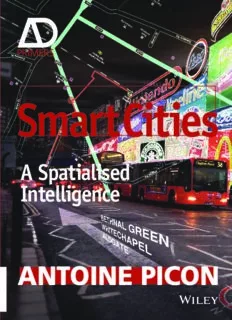
Smart Cities: A Spatialised Intelligence PDF
Preview Smart Cities: A Spatialised Intelligence
PRIMERS Smart Cities A Spatialised Intelligence ANTOINE PICON PRIMERS Smart Cities PRIMERS Smart Cities A Spatialised Intelligence ANTOINE PICON This edition first published 2015 © 2015 John Wiley & Sons Ltd. Registered office John Wiley & Sons Ltd, The Atrium, Southern Gate, Chichester, West Sussex, PO19 8SQ, United Kingdom For details of our global editorial offices, for customer services and for information about how to apply for permission to reuse the copyright material in this book please see our website at www.wiley.com. All rights reserved. No part of this publication may be reproduced, stored in a retrieval system, or transmitted, in any form or by any means, electronic, mechanical, photocopying, recording or otherwise, except as permitted by the UK Copyright, Designs and Patents Act 1988, without the prior permission of the publisher. Wiley publishes in a variety of print and electronic formats and by print-on-demand. Some material included with standard print versions of this book may not be included in e-books or in print-on-demand. If this book refers to media such as a CD or DVD that is not included in the version you purchased, you may download this material at http://booksupport.wiley.com. For more information about Wiley products, visit www.wiley.com. Designations used by companies to distinguish their products are often claimed as trademarks. All brand names and product names used in this book are trade names, service marks, trademarks or registered trademarks of their respective owners. The publisher is not associated with any product or vendor mentioned in this book. Limit of Liability/Disclaimer of Warranty: While the publisher and author have used their best efforts in preparing this book, they make no representations or warranties with the respect to the accuracy or completeness of the contents of this book and specifically disclaim any implied warranties of merchantability or fitness for a particular purpose. It is sold on the understanding that the publisher is not engaged in rendering professional services and neither the publisher nor the author shall be liable for damages arising herefrom. If professional advice or other expert assistance is required, the services of a competent professional should be sought. A catalogue record for this book is available from the British Library. ISBN 978-1-119-07559-2 (paperback) 978-1-119-07560-8 (ebk) ISBN 978-1-119-07561-5 (ebk) 978-1-119-07562-2 (ebk) Executive Commissioning Editor: Helen Castle Project Editor: Miriam Murphy Assistant Editor: Calver Lezama Cover design, page design and layouts by Karen Willcox, www.karenwillcox.com Printed in Italy by Printer Trento Srl Cover image © Keiichi Matsuda Acknowledgements In a book like this one, exchanges have a special importance. I would like to thank here the individuals involved in digital and smart city development, colleagues and friends, whose input has been very helpful to me. I am indebted to Joëlle Bitton, Jean Daniélou, François Ménard, Dominique Lorrain, François and Manuel Gruson, Nikola Jankovic, Nashid Nabian, Nicolas Nova, Colin O’Donnel, Carlo Ratti, Molly Wright Steenson and Ornella Zaza for their information and ideas. Special thanks to Marie Veltz who has shared with me the abundant documentation that she has gathered on smart cities. My research has been facilitated by a Canadian Centre for Architecture Senior Mellon Fellowship. I would like to thank here Maristella Casciato, Mirko Zardini and Phyllis Lambert, who have been instrumental in making my stay at the Canadian Centre for Architecture especially fruitful. Abigail Grater has done a wonderful job translating my sometimes intricate French into English. At Wiley, Helen Castle’s constant support has proved invaluable. Caroline Ellerby has played an essential role in gathering the illustrations, a process that has proved quite challenging at times. My deepest gratitude goes to Virginie Picon-Lefebvre whose careful reading and insightful comments have been, as always, essential. Contents Acknowledgements 005 Introduction: A New Urban Ideal 009 Spatialised Intelligence 011 Technology, Space and Politics 015 Chapter 1: The Advent of the Smart City, from Flow Management to Event Control 023 Defining the Smart City 024 Self-Fulfilling Fictions 030 The Sentient and Sensory City 037 Massive Quantities of Data 046 What Happens 052 Chapter 2: A Tale of Two Cities 067 Neocybernetic Temptation 069 The Cyborg-City Hypothesis 078 Spontaneous City, Collaborative City 083 The Digital Individual 091 Chapter 3: Urban Intelligence, Space and Maps 105 Augmented Reality and Geolocation 106 Towards Three-Dimensional Urbanism 110 A New Relationship to Infrastructure 119 The Stakes of Representation 124 A New Aesthetic 138 Laboratories of Public Life in the Digital Age 140 Conclusion: The Challenges of Intelligence 145 The Limits of All-Digital Solutions 146 The Necessary Diversification of Scenarios 149 Public/Private 153 From Event to History 154 Bibliography 158 Index 162 Photo Credits 167 IBM, infographic on ‘building a smarter city and state’, 2013 IBM has played an important role in the rise of the smart city ideal. This infographic was released to illustrate a series of projects launched in partnership with the city of Boston and the state of Massachusetts. It features some key elements of the smart city approach such as a better management of urban infrastructure and the quest for greater environmental efficiency.
Description: